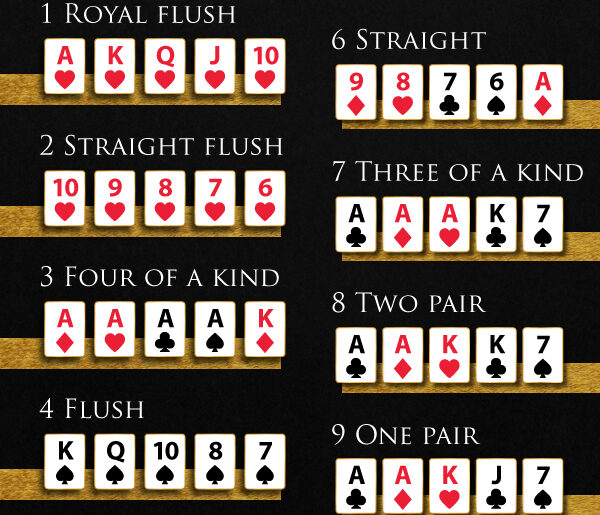Short Deck Holdem Strategy
ShortDeck Hold’em (6+ Hold’em) Strategy In this continuation into a look at 6Plus Hold'em we have some starting hand tips for Short Deck Hold'em. Including tips on how to be balanced, unpredictable and become very profitable in this new lucrative game. Take a look at the post and jump ahead of your competition.
What is Short Deck Poker?
If you take out from a deck the 2’s, 3’s, 4’s, and 5’s, you end up with a short deck of 36 cards. Playing poker variants with a short deck is what short-deck poker is all about. This simple modification changes a lot. First, it alters the hand ranking, as the likelihood of making different hands changes. Even more, playing with a short deck changes the dynamics and makes for action-packed variants like 6+ Holdem that is gaining popularity fast across the world!
You can play many poker variants using a short deck, but the most popular is Short Deck Holdem (or 6+ Holdem). Six-Plus Holdem resembles no-limit Holdem but is played with a short deck.
- Short Deck Hold’em Poker Strategy: Preflop Play Just looking at the rules of the game, it seems it isn’t all that different from standard Texas Hold’em. This may seem true on the surface, but Short Deck poker requires a completely different strategic approach.
- Short-Deck strategy is an extremely new game and the perfect strategy is still being developed. Just like Hold’em in the early 2000s it’s going to take some time for correct strategy emerge and currently there just aren’t that many resources for learning the game.
- Six Plus Hold’em (6+), also called Short Deck Poker, is a community card poker game based on Texas Hold’em. While most of the rules are the same, there are three main differences between the two. In 6+ Hold’em, the cards from deuces through fives are removed to make the total deck just 36 cards instead of the usual 52.
Packed with action, 6+ Holdem is an exciting variation that has captured the interest of many poker pros, like Tom Dwan and Phil Ivey, and has been introduced in major poker sites, like Pokerstars and Partypoker, and even in the World Series of Poker.

Who invented short deck poker?
It is a general consensus that short stack poker originated in China. However, variants of the game have been also played in Greece, called Poka, using a deck of 32-40 cards and a modified hand ranking. The game gained popularity across the world since 2015, when Phil Ivey and Tom Dwan embraced 6+ Holdem, the Texas Holdem short deck equivalent, and promoted it.
What are the rules of Six-Plus Holdem?
In 6+ Holdem, the rules are very similar to regular Holdem. Each player is dealt two hole cards, and five community cards are dealt in three stages; three on the flop, one on the turn, and one on the river. Each step is accompanied by a betting round.
If the hand goes to showdown, the payer having the best possible five-card hand, using any combination of his hole cards and the community cards, wins the pot.
If you are unfamiliar with any of the specifics of the action and betting, you can check out here the rules for Texas Holdem.
However, there are some important differences in the rules that you need to know.
Short Deck Holdem Strategy Games
Flushes rank higher than full-houses
First and foremost, you must be careful as the hand rankings differ from the typical full deck hand rankings! This derives from the fact that, with a short deck, the likelihood of making various hands changes. Be careful, though, because the ranking rules may differ from place to place.

Flushes are more scarce than full-houses, and they rank higher in most casinos. Also, three-of-a-kind is rarer than a straight by the river (on the flop it is easier). However, in most cases, straights rank higher than three-of-a-kind.
Bellow is the hand ranking used in many poker sites, like Pokerstars and Partypoker, that was also used in the 2019 World Series Of Poker, Short Deck No-Limit Hold’em event. Keep in mind that the ranking used is not the same in all poker sites and casinos, so you must be careful!
Short Deck Strategy
Modified Hand Rankings for six-plus Holdem
| Rank | Example | Hand Name | Probability |
|---|---|---|---|
| 1 | A♥K♥Q♥J♥T♥ | Royal Flush | 0.02% |
| 2 | Q♣J♣T♣9♣8♣ | Straight Flush | 0.11% |
| 3 | Q♠Q♣Q♦Q♥A♠ | Four of a Kind | 0.57% |
| 4 | A♦J♦9♦8♦6♦ | Flush | 2.12% |
| 5 | 9♠9♣9♦J♠J♥ | Full House | 7.59% |
| 6 | 9♣8♥7♠6♠A♥ | Straight | 14.14% |
| 7 | 9♣9♥9♦7♥6♠ | Three of a Kind | 7.25% |
| 8 | A♣A♥T♣T♦7♦ | Two Pair | 38.3% |
| 9 | K♣K♥J♠T♥6♦ | One Pair | 27.74% |
| 10 | A♥K♣J♠9♦7♦ | High Card | 2.81% |
Antes and a Button Blind
Another important difference lies in the structure of the forced bets. Again, there is no standard structure, and the forced bets may differ in various poker sites and casinos. However, it is common to see an ante and a button blind, instead of a small and big blind structure. In this case, the player at the left of the button acts first preflop.
Aces can still make low straights!
Like in standard Holdem, aces can make the highest possible straight, and the lowest. So, in 6+ Holdem, 9876A also counts, and is the lowest possible straight!
Let’s take a look at some basic strategic considerations
Hand Value is Different
The first thing to notice is that it is much easier to make big hands, like full houses and even quads! Waiting to make quads in full deck Holdem can take for ages. However, in short deck poker, making monster hands is not that rare! This is the main reason that makes the game fun and the action fast!
In theory, making strong hands should not affect the action. You will still make a 10% or better hand, well, 10% of the time. However, reality differs.

In Texas Holdem, more often than not, players miss the flop, and the action becomes limited. It is easier to let go of your hand when you flop little or nothing, like a high card or bottom pair. In contrast, in 6+ Holdem, mediocre hands look better! Therefore, inexperienced players can get carried away and give more action than what is justified.
Draws Change Drastically
Short Deck Holdem Strategy Tips
The second thing to notice is that draws change drastically! Flush draws become harder to make as you only have five outs to make them (instead of 9). Even if flushes are harder to make, they can break a full-house, and can win huge pots!
On the contrary, straight and full-house draws become easier to make. With straights ranking higher than three-of-a-kind, they become a great hand as it is easier to make and, at the same time, outrank a set. If you have an open-ended straight draw on the flop, you can make it by the river about 45.6% of the time!
Therefore, connected cards and even one-gappers are strong starting hands. Keep in mind that in unpaired boards, it becomes very likely that one or more opponents have a straight, so you should be cautious. Also, don’t forget that a low straight with an ace is possible.
The Rule of 4 and 2, becomes the Rule of 6 and 3
In the tutorial on Counting Poker Outs, we saw that we can use the rule of 4 and 2 to make a quick estimation of the probability that you will hit one of your outs. As in short deck Holdem, there are about two-thirds of cards in the deck to draw from, the probabilities to hit an out are multiplied by a factor of 1.5. Therefore, we can use the same technique to make a quick estimation of the percentage of hitting a draw but use 6 and 3 as multipliers. So,
- With one card to come, multiply your outs by 3 (from flop to turn, or from turn to the river)
- With two cards to come, multiply your outs by 6 (from flop to river, useful in all-in situations when no more betting is to be considered).

Limping becomes an option
In no-limit Holdem, when someone is the first player to put money into the pot voluntarily, he mostly open-raises, and rarely limps. In Short Deck Holdem, open limping with some hands becomes also a viable option, as with the antes you get huge pot odds to try to limp.
Blockers count more!
In Short Stack poker, having a blocker decreases the probability that your opponents will make their hand more than in regular Holdem. With fewer cards in the deck, outs count about 50% more and blockers do too. For example, consider that you have a flush draw on the turn. If your opponent has no blocking cards, you have 5 outs out of 28 remaining cards, or 17.9% chance of making your flush. If he has one card of the suit that you draw to, you now have 4 outs, or about 14.3% chance of making it, significantly less!
The same goes for different types of blockers, like straight blockers.
Pocket pairs go up in value!

In 6-plus Holdem, you get dealt about 46% more often a pocket pair, so about once every 11 or 12 hands. Even more, in Short-Deck Holdem, pocket pairs hit a set or better about 25% of the time (instead of 17% of the time in no-limit Holdem)!



